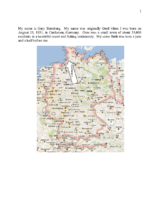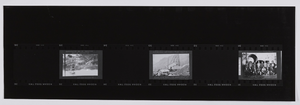Search the Special Collections and Archives Portal
Search Results
Tonopah and Tidewater Railroad Records
Identifier
Abstract
The Tonopah and Tidewater Railroad Records (1905-1977) contain correspondence, purchase requisitions, bills of lading, freight reports, and waybills. Also included are a ledger book, a rubber stamp, and a booklet, "Diagrams of Locomotives and Tenders." Incorporated in 1904, the Tonopah and Tidewater Railroad operated for 35 years, connecting Ludlow, California with Beatty, Nevada by way of Death Valley on the Santa Fe Railroad main line. The records are concentrated on the later years of the railroad from 1930 to 1940.
Archival Collection
Frank Williams Papers on Early Nevada
Identifier
Abstract
The Frank Williams Papers on Early Nevada (1892-1946) consists of manuscripts written for the most part by Frank Williams, an early resident of Southern Nevada. The collection includes Williams' autobiography as well as histories of Goodsprings, Potosi Mine, Mesquite Valley, and the Yellow Pine Mining districts. Finally, this collection contains reports and material reflecting Frank Williams' two terms as University Regent (1909-1912 and 1923-1942) at the University of Nevada, Reno, and his four terms in the Nevada State Assembly.
Archival Collection
Rich Rizzo Professional Papers
Identifier
Abstract
The Rich Rizzo Professional Papers (approximately 1960-2022) are comprised largely of photographs documenting the life of Las Vegas, Nevada dancer and choreographer Rich Rizzo in shows such as Jubilee! and Lido de Paris in Las Vegas and in Paris, France. The photographs show rehearsal and performances, Rizzo with his partner and fellow choreographer Winston Helmsley, dancers and showgirls, Donn Arden, and Miss Bluebell. Other types of material include business and personal correspondence, contracts, production prospectives and set designs, show programs, and costume design photographs.
Archival Collection
Marge Jacques Papers
Identifier
Abstract
The Marge Jacques Papers (1960-1990) comprise the personal papers of Marge Jacques, a prominent member of the Las Vegas, Nevada gay and lesbian community, and owner of the gay bar, Le Cafe. The papers contain correspondence, licensing records, financial statements, and artifacts from clubs that Jacques owned or managed. Also included are photographs, videotapes, audiotapes, newspaper clippings, and Gipsy Nightclub promotional material.
Archival Collection

Biographical essay by Gary Sternberg, 2014
Date
Archival Collection
Description
Gary Sternberg grew up in Germany, witnessing anti-Semitic propaganda as early as age 7. He describes some of the experiences his father endured at a concentration camp, and his escape to China. He and his mother reunited with his father in Shanghai in 1940. They left Shanghai in 1948, eventually settling in Cleveland. He and his family came to Las Vegas in 1969.
Text
Ford, Jean, 1929-1998
Nevada politician and women's advocate Imogene "Jean" Young was born in Miami, Oklahoma, on December 28, 1929, to Daisy Adelphia (Flook) and Clarence Nathan Young. She had one brother, Byron Young. Her family moved to Joplin, Missouri, where she attended kindergarten through high school. In 1951 she graduated from Southern Methodist University in Dallas, Texas with a B.A. in Sociology. After graduation she worked as a recreational therapist for the American Red Cross in military hospitals until 1955.
Person
Ham, Artemus W., Sr., 1892-1970
Artemus W. “Art” Ham Sr. (1892-1970) was a highly respected Las Vegas, Nevada attorney and a philanthropist who devoted his work towards the Las Vegas community as well as the development of the Las Vegas strip. Ham was also president of the Las Vegas Chamber of Commerce in 1929 and a recognized supporter to the University of Las Vegas, Nevada (UNLV). He became active in the city’s real estate and had faith in the future of Las Vegas.
Person

Film strip of individuals or Hoover Dam construction, image 012: photographic print
Date
Archival Collection
Description
Image
Albert S. Henderson Photograph Collection
Identifier
Abstract
The Albert S. Henderson Photograph Collection (1860s-1959) primarily contains black-and-white photographic prints of Albert S. Henderson and his family. Also included in the collection are photographic prints of Henderson during his tenure as a Nevada legislator and district judge. Other materials include postcards, negatives, and a tintype.
Archival Collection
George Kelly Ryan Photograph Collection
Identifier
Abstract
The George Kelly Ryan Photograph Collection (1929) depicts waterways in Southern Nevada and Northern Arizona. The collection consists of eight photographic prints and two photographic negatives depicting Saint Thomas, Black Canyon, Boulder Canyon, and the Colorado River.
Archival Collection
